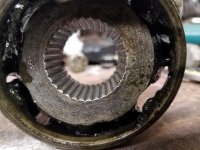superman22x
Plastic
- Joined
- Nov 5, 2017
Hello,
To start off... I'm still learning, and looking for some tips on cutting some splines. I am trying to make new CV axles for my LS3 944 out of a chunk of 4340HR I have. What I have seen on some YouTube videos is that people have used 90* double angle cutters for splines. Involutes would be ideal, but for splines, I think that splines are only involute due to ease of manufacturing more than anything. So the double angle cutter is used. But my thought is that rather than spend $100 on a decent double angle cutter that will not get used for anything else likely, is there any reason I can't just use a standard end mill on the 45* tangent of the shaft? See picture below, it would be the image on the left vs image on the right for the double angle cuter. The spline roots would be slightly different due to the angle of the flutes, but that is not important I think? If it is, something like a keyway cutter would work, that has basically 90* flutes to the rotation of the cutter. Am I missing something else?
Looking for input, maybe there is a better way to do this all together.

These are the splines I'm trying to cut for reference:

To start off... I'm still learning, and looking for some tips on cutting some splines. I am trying to make new CV axles for my LS3 944 out of a chunk of 4340HR I have. What I have seen on some YouTube videos is that people have used 90* double angle cutters for splines. Involutes would be ideal, but for splines, I think that splines are only involute due to ease of manufacturing more than anything. So the double angle cutter is used. But my thought is that rather than spend $100 on a decent double angle cutter that will not get used for anything else likely, is there any reason I can't just use a standard end mill on the 45* tangent of the shaft? See picture below, it would be the image on the left vs image on the right for the double angle cuter. The spline roots would be slightly different due to the angle of the flutes, but that is not important I think? If it is, something like a keyway cutter would work, that has basically 90* flutes to the rotation of the cutter. Am I missing something else?
Looking for input, maybe there is a better way to do this all together.

These are the splines I'm trying to cut for reference:

Last edited:


 I never could find anyone who wanted to pay that much (last I checked it was $18 a pound, most likely more now. But the heat treat is cheap
I never could find anyone who wanted to pay that much (last I checked it was $18 a pound, most likely more now. But the heat treat is cheap 

